Hearty thanks are expressed to Dr Anthony Reed for his help compiling this history of Hamp House
Hamp Cottage is a delightful mid-eighteenth century building next to the busy Taunton Road. It is rightfully listed Grade II. It was one of the service buildings for Hamp House, a large stately home which once stood behind, but was demolished in 1970. The cottage was the home of the groom and gardener of the big house, and was attached to a range of service buildings for the house, including sheds and stables.
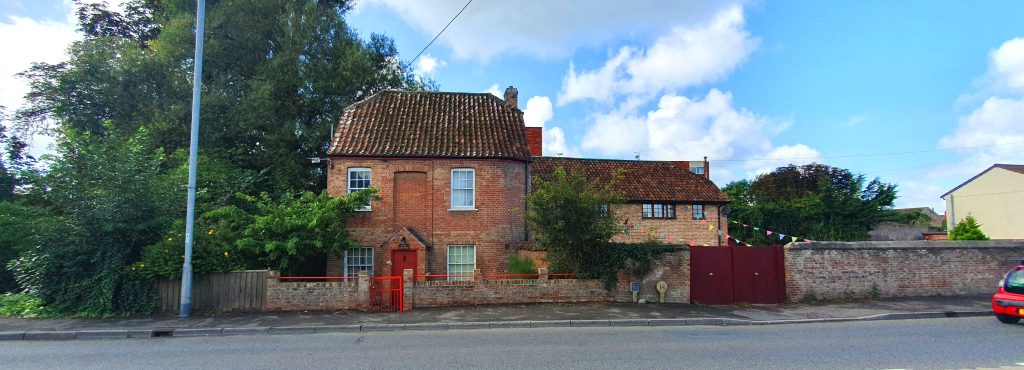
It is difficult to know the exact relationship between house and cottage and whether the two were contemporary. Photographs of the façade of Hamp House taken in about 1865 suggest a building of mid-eighteenth century date. Without knowing anything about the internal features, it is not possible to say if it is any older. No earlier documentary evidence has been found yet.
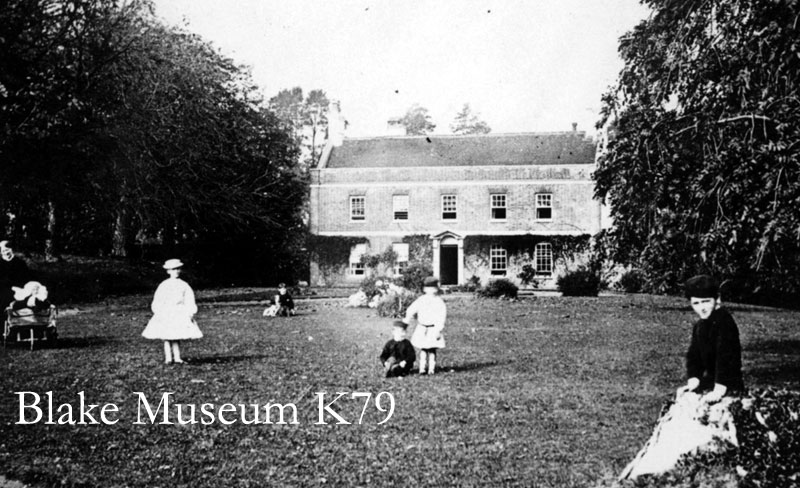
Hamp House appears to be shown, in very small detail, on the 1802 Ordinance Survey map for Burnham on Sea. The first solid documentary evidence comes in 1835, when a John Chapman of Hamp House, Bridgwater is mentioned (Somerset Heritage Centre DD/ED/1835/149). A John Chapman aged 70 of independent means is mentioned in the 1841 census living in Hamp. Living with him were widow Elizabeth Davie, aged 65 (possible his sister), then various servants. Hamp House is mentioned in passing again in the Bath Chronicle and Weekly Gazette of 20 August 1844, when it reported the death of Mrs Elizabeth Davie on July 18th ‘after a short but severe illness’. It noted that her son was the Rev. John Chapman Davie of Wells and her brother was John Chapman of Hamp House. In the same newspaper, dated 24 April 1845, the death of John Chapman ‘a magistrate’ was recorded on 16 April.
The Dorset County Chronicle of 8 May 1845 advertised the subsequent sale of John’s possessions at Hamp House. The auction would take place on 13th and 14th May and would include
‘the whole of the neat and valuable household furniture, china, glass, 240 ounces of plate, plated articles (including a handsome tea urn), handsome thorough-bred Chestnut Mare, a useful horse, pair of beautiful Exmoor ponies, 12 hands high, with long manes and tails, 3 and 4 years old; neat and modern pony phaeton, in perfect condition, (under duty) 2 chariots, a double-body phaeton, quite new, single and double sets of harness, 31 hogshead of superior cider, a quantity of excellent casks, 12 tons of prime meadow hay in 3 ricks, with a great variety of other useful property.’
Oddly, the Tithe apportionment survey, usually dated to 1840, has Hamp House described as ‘House and Lawn’, owned by Charles Chapman and occupied by Richard Gooding. Chapman owned various adjoining plots of land, including those across the Taunton Road, where brickyards were operating. Charles is possibly John Chapman’s son: he was aged 60 in 1841 and living in North Petherton. In the 1841 census a 53 year old Richard Gooding ‘farmer’ was living at Rexworthy Farm in Durleigh, which suggests that the Tithe apportionment survey was made after 1845, and that Gooding moved in after the death of John Chapman. Gooding is listed in Hamp in the 1851 census, now described as ‘landed proprietor’ and living with two sisters and a female cousin and various servants.
The c.1854 Town Plan of Bridgwater shows the property in detail, showing a rectangular house and a detached zig-zag-shaped service range close to the road.
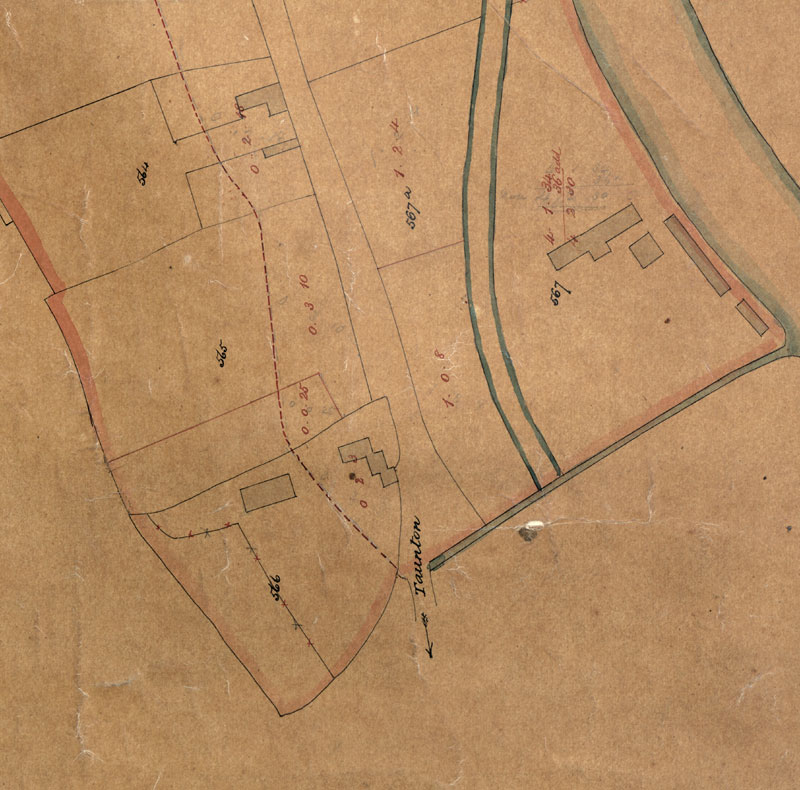
In 1861 another auction was held at Hamp House, following the death of Richard Gooding. The advert in the Bridgwater Mercury of 19 January 1860 goes into great detail about the contents of each room:
SUBSTANTIAL AND VALUABLE FURNITURE, HEIFER, BAY HORSE, CARRIAGE, HARNESS, CIDER, CIDER PRESS, APPLE MILL, EMPTY CASKS, and Miscellaneous Effects, late the property of Richard Gooding, Esq., deceased, viz:-
IN THE DINING ROOM AND VESTIBULE
Mahogany dining, round, and square tables, mahogany framed and hair-stuffed lounge, with extra cushions; Mahogany easy chairs, with spring seats; Mahogany framed and hair stuffed chairs, mahogany cabinets, mahogany 6 feet sideboard, handsome mantle glass in gilt frame, plates 36 inches by 27 inches; mahogany butler’s tray and stand, Derby tray, with cushions; Brussels carpet, hearthrug, damask window draperies, pole fire screens, four-lap screen, cast fender, steel fire set, several prints framed and glazed, copper coal scuttle and scoop, Palmer’s candle lamp, mahogany hatstand, skin and other mats, a day dial, etcetera
IN THE DRAWING ROOM
Handsome pattern Brussels carpet (nearly new), hearthrug to match, rosewood centre table, rosewood chairs, pair rosewood card tables, rosewood frame and her stuffed lounge with extra cushions; Mahogany frame and hair stuffed easy chat, rosewood work tables, ottomans, mahogany work and other tables, mahogany five-tier whatnot, handsome mantle glass in gilt frame, plate, 39 inches by 28 inches; damask window draperies, brass fender, steel fire set, mental ornaments, several Prince framed and glazed, copper coal skuttle, etc
IN THE BEDROOMS
Richly carved fourpost bedstead, with damask drapery; half-tester, tent, sofa, and other bedsteads, with and without furniture; hair and wool mattresses, seven very superior geese feather beds, with bolsters and pillows; Marseilles and other quilts, white and other counter pains, several excellent blankets, mahogany wardrobe, mahogany circular front and other chests of drawers, mahogany and marble top washstands, toilette sets mahogany bidets, mahogany and pointed dressing tables, mahogany commode, mahogany slab and other dressing glasses, Brussels and other carpets, stair carpeting, brass stair rods, druggetting; cane and rush seat chairs, fire sets, window draperies, linen chest, clothes boxes, mahogany painted towel horse, etc
IN THE CHINA PANTRY, KITCHENS, ETC
Breakfast, dinner, and tea services, cut decanters, runners and wines, custard cups, finger glasses, cut salts, water carafes, mahogany lap and round tables, deal kitchen and other tables, kitchen chairs, dresser and shelves, eight-day clock in mahogany case, napkin press, Master’s patent knife cleaner, settle, block tin dish covers, copper and iron tea kettles, copper warming pan, boilers, saucepans, brass milk pans, brass kettle, tin milk cans, bacon and plate racks, Japan plate warmer, bottle Jack, pewter hot water plates and dishes, steel yards, cocoa fibre matting, tubs, buckets, coal scuttles, fenders, fire sets, metal and other teapots, dinner and tea wear, knives and folks, fish kettle, Dutch oven, sundry tinware, course ware, etc
OUT-DOOR EFFECTS
Double-iron screw cider press, apple mill, cider vats, several empty vats, hogsheads, and half hogsheads, ladders, steps, salting trendle, jibbing, corn chest, grindstone, iron pigs, trough, a cross-bred Heifer in full milk, a Bay horse, 15 1/2 hands high, good in saddle and harness, an excellent Broughham, with pole and shafts, and lamps complete, asset of nearly knew carriage harnesses, saddle and bridle, about 20 iron hurdles, about 8 hogs heads of prime cider etc.
Following after Gooding, in 1861 the house was rented by Paul Octavious Haythorn Reed, a Bridgwater solicitor and later Town Clerk, who would be most associated with the house. He was still living in Castle Street at the time of the Census in April, but his family had moved by December, which we learn from the death of his son Hamilton.
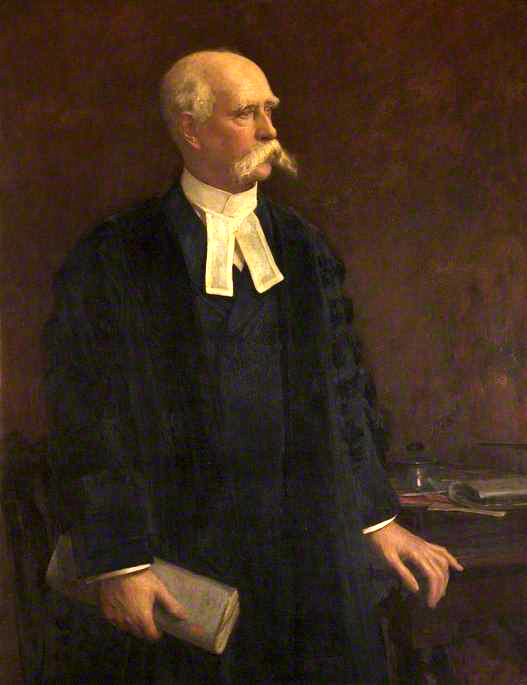
An indenture made on 16 July 1862 set Hamp House and its estate in trust and rented out for the benefit of Flora Evelyn Kinglake, who was about to marry Richard Meade-King. This was drawn up by her father, Reverend William Chapman Kinglake (whose wife was Matilda, nee Chapman). This trust would own the house up to 1919, at which time Flora was still alive.
Sadly, Charlotte Reed, wife to Paul, died aged only twenty-seven on 30 July 1862 at Hamp House after being ill for three weeks. The house is first photographed in 1864 (see above), and several of Paul and Charlotte’s children and shown on the lawn.
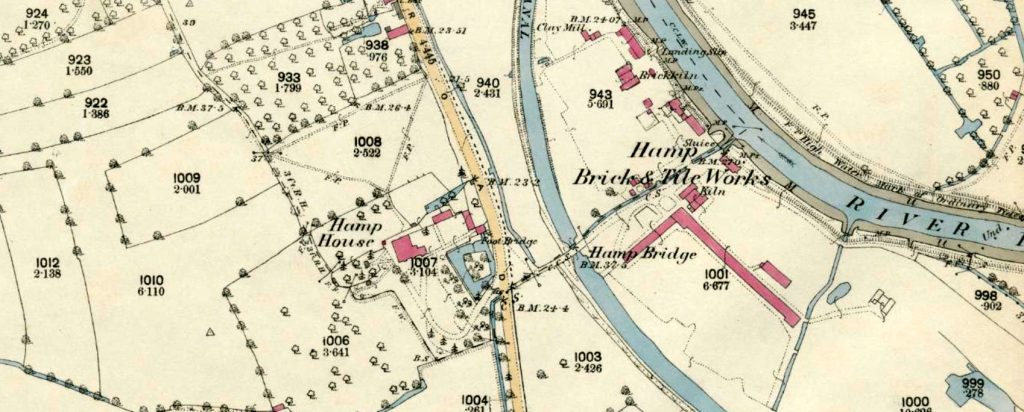
Paul Reed seems to have remodelled the house by the time of the 1887 OS 25” to the mile map of the area. Compared to the 1854 depiction of rectangular block, the house is now a large L-shape with bay windows. Oddly, a large square pond is shown with an island in the middle, which does not appear in earlier depictions. A section of this little moat attached to the end of Hamp Cottage. It was presumably an ornamental pond, that would have helped drainage on this marshy land. It may have once been an old clay pit for the nearby brickyards. That it attached to Hamp Cottage may be behind the Reed family story that the cottage was once a mill. This is not impossible, but from the map evidence it’s a puzzle to workout how that might have worked, or why the pond was connected to the house at all. The site of the pond was not built over in 1970, and is now open green space.
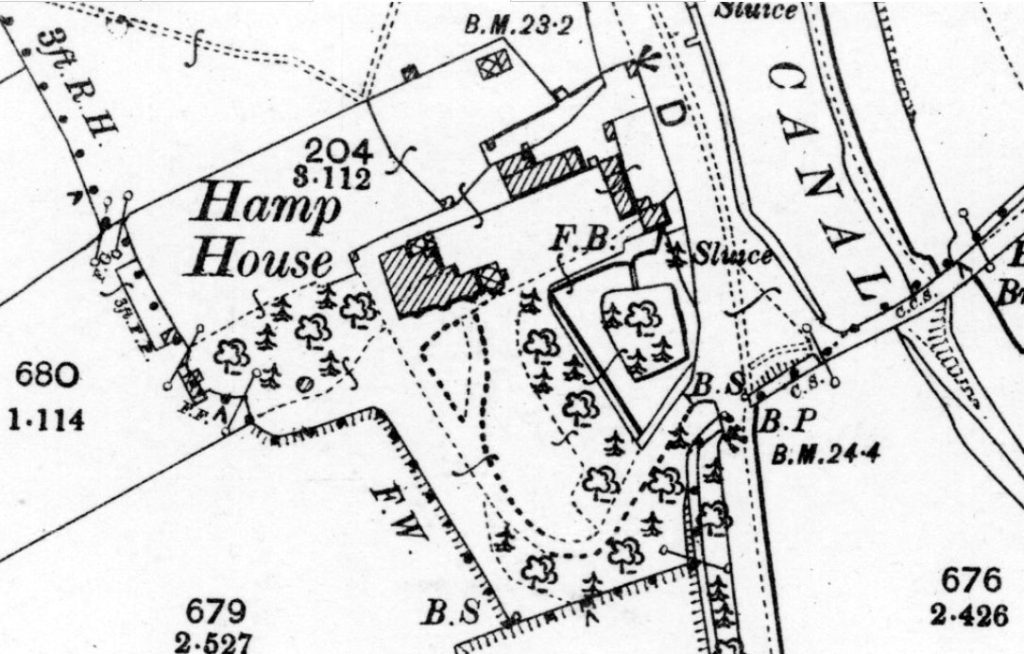
By the time of the 1904 OS map, two glass houses had been added to the front and back of the house. Paul died in 1903 and the following year his son, Ernest Lancelot Henry Reed became one of the trustees of the Hamp House Trust.
Regardless of Paul’s death, the house would long be known popularly as ‘Paul Reeds’, through to the 1940s and 1970s (Somerset County Herald and Taunton Courier, 30 May 1942).
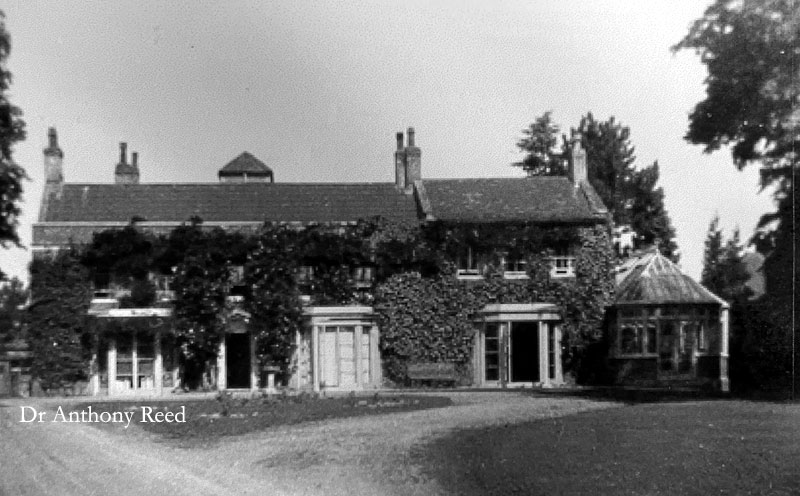
Around 1914 the house was rented out to the Jones sisters of Ireland. They were the daughters of Humphrys Jones, JP for Carrickaderry (c1791-1869), prosperous landowning women, who had left Ireland, probably due to land reform agitation. Frances died on 11 February 1914, not long after moving to their new home. Eliza died on 5 February 1919 at Hamp House. Both are buried in the Wembdon Road Cemetery, and full biographies for them can be found on the website of the Friends of the Wembdon Road Cemetery.
On 29 September 1919 Mrs Flora Evelyn Meade-King (nee Kinglake) and the trustees of the Hamp House Trust (which included Ernest Reed) conveyed Hamp House to Ruth Marie Reed, Ernest’s wife. Ernest and Ruth moved to Burnham on Sea in about 1930. The house was then purchased by a Mr Brown, while the adjoining Hamp Cottage and three fields were sold to Mr Coombes, groom and gardener of the house.
In 1970 the house and most of the land was sold to developers. Mr Coombes kept Hamp Cottage, and his daughter Dorothy lived there until her death in 1999.
The site was redeveloped by R.M. Smith Properties Ltd of Cossington and on 1 June 1971 new houses ‘with electrical central heating’ were advertised in the Bridgwater Mercury at ‘Paul Reeds’, Taunton Road.
